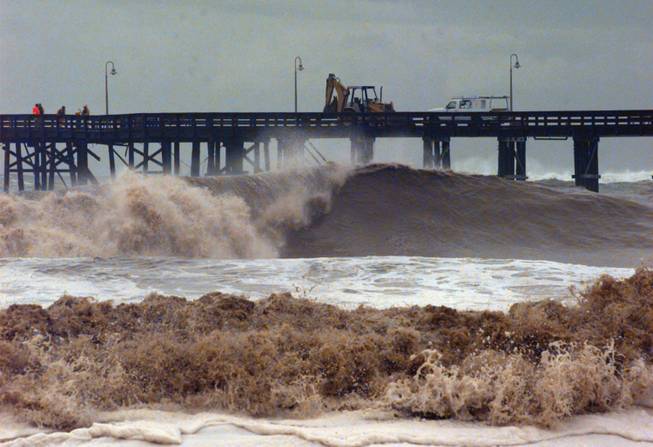
Nick Ut / AP
In this Feb. 2, 1998 file photo, work crews attempt to repair a damaged pier caused by waves that reached 15 feet from the massive El Nino-driven storm in Ventura, Calif. Evidence is mounting that the El Nino ocean-warming phenomenon in the Pacific will spawn a rainy winter in California, potentially easing the state’s punishing drought but also bringing the risk of chaotic storms like those that battered the region in the late 1990s.
Monday, Nov. 30, 2015 | 2 a.m.
More raindrops than ever may be falling on your head this winter.
Meteorologists say this year’s El Niño weather pattern is on track to be one of the strongest on record.
But that doesn’t necessarily mean this year will be the valley’s wettest. El Niño already is underway, and Las Vegas hasn’t yet experienced any storms as a result of the weather pattern.
What is El Niño?
The weather phenomenon is known for producing periods of heavy rain every three to five years in the southern United States.
Though winter rain is its signature, the phenomenon actually begins months before the rain hits, when the Pacific Ocean starts warming near the equator. The gradual warming causes storm patterns to shift, typically causing more rain in the southern United States, parts of the East Coast and Mexico, warmer-than-usual weather in the northwestern United States and Northern Rockies, and drier-than-normal conditions in the Ohio Valley and Great Lakes region.
El Niño and La Niña episodes typically last nine to 12 months, but some prolonged events may last for years.
How El Niño works
What is La Niña?
A La Niña weather pattern essentially is the opposite of El Niño, with colder-than-usual ocean temperatures in the Pacific Ocean along the equator. During a La Niña year, winter temperatures are warmer than normal in the Southeast and cooler than normal in the Northwest. Typically, the phenomenon means dry or only moderately wet winters for Southern Nevada.
1. El Niño develops when low-level easterly trade winds weaken.
2. Warm surface water shifts eastward, causing more thunderstorms to form over the equatorial central and eastern Pacific Ocean. The upwelling of cold water in the eastern Pacific is reduced.
Will it rain more than usual this winter?
It’s hard for meteorologists to predict exactly how much rain the valley will get this winter. “There could be a lot of days of a little rain or a few days of a lot; it’s hard to say,” said Andy Gorelow, a National Weather Service meteorologist. Meteorologists also won’t know when a storm is coming sooner than the typical seven to 10 day projections. Still, Gorelow said residents should prepare for extra rainfall now — just in case — by fixing leaky roofs and ensuring their tires are safe to drive on wet roads. “Be prepared for a wet winter. The potential is there,” Gorelow said.
FAQs
Strongest El Niños
Some of the strongest El Niños have caused extreme flooding in the West, killing several people and causing hundreds of millions of dollars in damage.
Among the recent strong El Niño episodes were 1972-73, ’82-’83, ’91-’92 and ’97-’98.
• Why is it called El Niño? El Niño means “the little boy” or “Christ child” in Spanish. The weather phenomenon originally was recognized in the 1600s by fishermen off the coast of South America. The name was chosen because the warm water events tended to happen in December, around Christmas time.
• Will it snow? Extra precipitation could mean more snow on Mount Charleston. But it’s hard to tell whether El Niño will bring snow to the rest of the valley, because temperatures vary with each storm system.
• Will El Niño help the drought? It’s possible El Niño could mitigate some of the effects of the drought, but that depends on the amount of rainfall El Niño brings and how quickly rain is absorbed back into the ground.
• Will El Niño cause floods? It could. In the past, El Niños have caused flooding in Southern Nevada, including from the Amargosa River in February 1969, the Virgin River in March 1995 and the Muddy River, Virgin River and Meadow Valley Wash in January 2005. The floods caused thousands of dollars in damage to homes and roads, and forced evacuations. Lake Mead, however, is unlikely to fill up, since El Niño likely won’t impact the Colorado River source region.

Join the Discussion:
Check this out for a full explanation of our conversion to the LiveFyre commenting system and instructions on how to sign up for an account.
Full comments policy